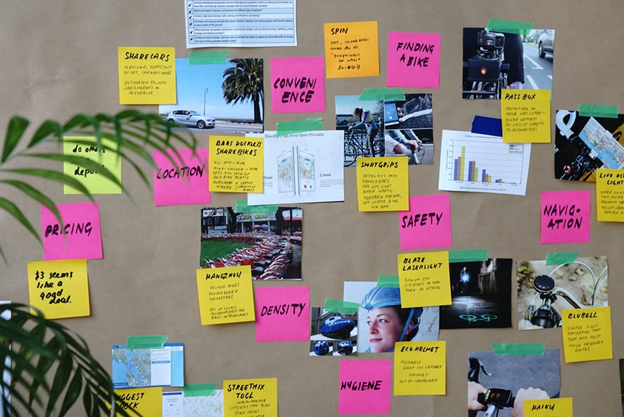A powerful method for uncovering new user insights and surfacing durable customer insights, is a research synthesis.
In academia, a literature review is a critical first step in understanding a problem space, developing early research questions, and refining hypotheses. In academe, a literature review comes before any further research is conducted. However, this tends not to be the case in industry.
In corporate tech, a research synthesis may be referred to as desk research, secondary research, or a literature review — I’ve heard all the above.
I’ve also observed that a research synthesis is not always considered an essential step in performing user research — many times research may occur without any desk research or synthesis at all.

While not necessarily problematic for informing products tactically, a lack of synthesis over time can lead researchers down a path of conducting the same research over and over again — moving the insights further away from timelessness and durability.
In the long-run, a lack of synthesis can be a detriment to user research, and ultimately, the user experience, product, and business strategy.
In this article, I focus on the process I’ve used to conduct a quality research synthesis and how I’ve used syntheses to make an impact on the Mixed Reality business.
Getting Started with a Research Synthesis
A research synthesis is built upon a mass of user insights, if done well, a synthesis includes insights from market research, sales, qualitative research, and quantitative research.
The more streams of insight that are woven into the synthesis, the better — the better your understanding of the user and customer you’re representing with your products and experiences. When looking at a breadth of insights, we can begin to use synthesis to better understand users.
In my career so far, I’ve identified a few cases in which a research synthesis can be highly impactful:
- A lot is known about a particular space, product, or user, and we need to distill high-level themes from a wellspring of amassed knowledge
- Very little is known about a product, space, user, or phenomena — it’s a good time to scratch the surface and inform your research plans and protocols
- New lines of business and business strategies are beginning to emerge, and we want user research integrated into that strategy or effort early on
Be strategic about thinking when to conduct your synthesis — look for gaps and impact points across the business where your work can gain traction.
A Framework for Conducting a Quality Research Synthesis
Step 1. Understand your motivations and goals for conducting a research synthesis.
A research synthesis should by no means be thought of as a replacement for field research or direct engagements with users. A synthesis supplements and compliments primary user research to form a deep, well-rounded understanding of our users and their experiences.
When conducting a research synthesis, take time to reflect on the outcome, impact, or goals have for the synthesis.
Some common goals that run throughout the syntheses I’ve conducted include:
- The need to fundamentally understand users and generate a set of initial user needs to inform product design and development
- The need to integrate user and customer insights into business strategy and shape the direction of the business
- The need to deeply understand a topic that is core to the user experience with a product — say for instance how individuals come to trust technology, how people pay attention for prolonged periods of time, or how teams make critical decisions
- The need to articulate and archive numerous user insights in one place that are timeless and durable — these insights are an be used over to inform the user experience or product direction, establishing within the research.
Some questions to guide your work at this stage might include:
- What do you and your team want to uncover through the research synthesis?
- What about your stakeholders — what can they learn from your user research synthesis?
- What do you, your stakeholders, and your collaborators wish you knew more about users or customers?
Step 2. Start generating research questions to guide the synthesis.
Approaching a research synthesis is much like preparing for a primary research study. It’s helpful to start out with a set of research questions to guide the work. And, we’re user researchers after all, we should be starting with questions.
You’re also about to start digging, sifting, and filtering information. It’s a lot. It can be really overwhelming — start with a core set of user research questions you want answer in your synthesis. This will help you stay focused and keep you, your team, and stakeholders centered.
That said, don’t shy away from adding more questions to your list or to a backlog. Those could become critical later. Stay curious — you’ll likely find something new from your adventures in the literature.
Some questions to help get you prepared for your first research synthesis may include:
- What are users’ needs when it comes to interacting with Product X or Product Y? What needs are being met? Are there new needs or gaps in our understanding of user needs?
- What have we learned about Product X or Product Y over the last 2 years? 5 years?
- What have we learned about customers using Product X and Product Y over the past 5 years? Have their needs changed over time?
- What user needs are most important when interacting with Products X and Y? What needs are less critical, but perhaps “delighters” or low-cost features or fixes that engineers and developers could address in their next sprint cycle?
- What are unmet or unidentified needs and pain points for users? What workarounds do users have in place to meet their needs when using your product?
Step 3. Begin your literature search.
Some good questions to ask yourself when you initially prioritize and guide your search include:
- What are the burning questions on the team? Of those research questions, which have the most impact on the user? What about impact on the team, the organization, or the business?
- What gaps in knowledge on the topic you’re researching have existed for quite some time across users, the business, or the team?
- What do collaborators and stakeholders really need to know now to guide product design or a larger strategic research effort?
- What is the impact of not answering some of these desk research questions?
Hone your search criteria further by developing a core list of key search terms or keywords. Use the same key terms across your search tools (whether these be internal or external libraries) — this will help you maintain consistency and reduce the number of returns in your search.
Here is a sample set of key terms we might use for a report on augmented and virtual reality technologies:
- Augmented reality, mixed reality, virtual reality
- Accessibility in AR and VR
- Literature review, systematic review, meta-analysis
A tip worth highlighting is to explicitly include the key terms such as literature review or systematic review in your literature search for articles in research libraries.
It’s highly likely that a team of researchers has already done a great deal of synthesis and summarizing of scientific insights and published these in a literature review or systematic review.
When done well, a scientific literature review or systematic review summarizes tens to hundreds of research studies and distills the findings from all of these articles into tangible insights. Sure, these reviews are academically written, but these insights can be woven into your user research insights and the story you are telling as it relates to your product or experience.
Some research library and search tools that may help get you started include:
- Microsoft HITS — our internal user insight research library
- PsycINFO, EBSCO, JSTOR, PubMed — reputable and credible databases of scholarly, scientific journal articles and conference proceedings about people and various psychological and sociological phenomena
- IEEE, ACM, CHI, HFES — reputable and credible scholarly conference proceeding databases and search tools
- Nielsen-Norman Group — leaders in user experience research and training
- Google Scholar and ResearchGate
A quality synthesis will gather and collect a lot of articles and threads of data upfront. Anecdotally speaking, the more articles gathered, the richer, and more articulate the user insights. If you’re conducting desk research for the first time, aim for more.
I highly recommend avoiding setting a limit on the number of articles (say 5 or 10 articles) you need to gather for a ‘sufficient’ synthesis — setting a strict count on articles doesn’t necessarily make for a quality synthesis.
Step 4. Manage and distill your user insights.
Now that you have gathered lots of information, critically think about how this knowledge needs to be organized to inform products, experiences, and strategies.
I don’t have the perfect tool for organization, but I highly recommend finding what works best for you and how you like to work. Maybe you go analog and cover a conference room wall with sticky notes — or perhaps you have a stellar Miro or Figma setup to organize themes and insights. Do you!

Once you’ve organized your files, data, anecdotes, and other synthesis inputs, I recommend reflecting on your themes and research questions to guide your writing.
Some helpful questions to ask yourself at this stage might include:
- What do your stakeholders need to know immediately?
- What questions can wait or be backlogged into another sprint or Version 2.0 of the product?
- What’s the impact to a user or customer if a particular research question is addressed now? What about if it is answered later?
Start reading your articles, taking notes, and analyzing datasets. Treat your synthesis like user research — ask questions about what you’re reading and the trends that start to unfold.
Some questions to reflect on at this stage might include:
- What are consistent themes across the streams of data and information you gathered?
- What are consistent user needs or user pain points emerging across scholarly articles or internal user reports? Why?
- What continues to be an unmet need or unaddressed user pain point over time? Why? What about across data streams? What does the qualitative research say? What about the quantitative research?
- What are new user insights? Do these contradict older user insights? Why?
From here, start outlining your synthesis report. I prefer to organize by major research questions and the questions my stakeholders are asking.
Step 5. Share and communicate your user insights.
Once your user research synthesis has reached a shareable form, communicate your findings to stakeholders and decision makers. Help get it into a product or experience sprint or backlog — champion your insights.
Share your work as much as possible. Because a synthesis can be durable and long-lasting, it is a pool of knowledge that collaborators can return to over and over again for insight and direction.
Step 6. Maintaining your research synthesis.
Research syntheses can evolve over time — they are not stagnant and new knowledge should be incorporated as it is gleaned.
This evergreen philosophy is worth considering when beginning your literature search. It can help with rigorously prioritizing aspects of your synthesis, and ensure you stay in tune with trends and findings related to your research questions, which should evolve over time.
When we learn more about users and customers, and we gain new insights, this should be integrated into the synthesis. Or, perhaps, it spurs a new synthesis. What matters is the knowledge is surfaced with product stakeholders and other user researchers.
Consider how your pastiche of insights may scale or grow over time. Knowledge is a garden to be tended and a research synthesis is no different.








